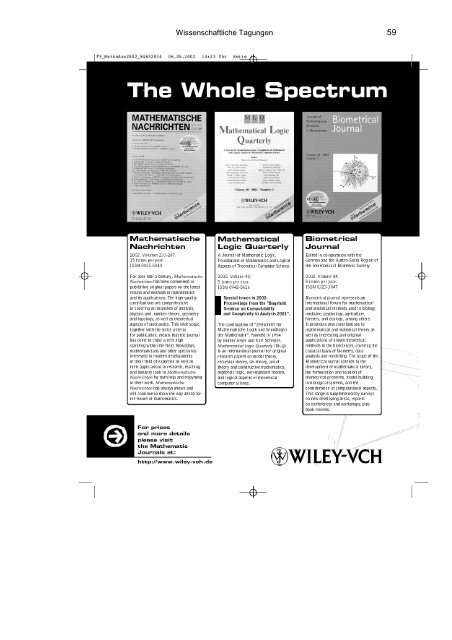GAMM Rundbrief 2002/Heft 2
GAMM Rundbrief 2002/Heft 2 GAMM Rundbrief 2002/Heft 2
58 Wissenschaftliche Tagungen Gent in 1999. The conference provides a forum for the presentation and discussion of research in the general area of multigrid methods. Topics Multigrid methods, focussing on robustness, adaptivity, algebraic multigrid, wavelets, parallel methods, optimization and inverse modelling, software and tools. Applications of multigrid, paticulary in computational fluid dynamics, porous media flow, computational mechanics, chemical engineering, biotechnology and statistical physics. Abstracts Please submit your abstracts by May 32st. Registration / Information Jochen Hittler, Tel: ++ 49 (0) 6221 54 88 15 Oktavia Klassen, Tel: ++ 49 (0) 6221 54 88 54 Simultation in Technology Center Im Neuheimer Feld 368 D-69120 Heidelberg fax : ++ 49 (0) 6221 54 88 60 mail: emg02@iwr.uni-heidelberg.de web: http://www.wir-bawue.de October 07 – 11, 2002 Moving Discontinuities in Crystalline Solids Advanced School: Coordinated by F.D. Fischer, Montanuniversität, Leoben, Austria M. Berveiller, LPMM - ENSAM, Metz, France The thermomechanical behaviour of most of the crystalline solids is controlled by: 1.thermoelastic deformations of the crystal lattices, 2.inelastic deformations resulting from nucleation, motion and annihilation of lattice discontinuities. Associated with these defects are discontinuities of the thermoelastic behaviour and (or) inelastic strain discontinuities. The “static” part of the problem (determining the stress fields related to these defects) is well known since the sixties. More recently, a great interest was devoted to problems connected with the movement of discontinuities, and with a more generalized definition of “forces”. Some of these problems are listed below: 1. What is the thermodynamic (driving) force responsible for the evolution of the interfaces whenever the chemical composition is changing or not? 2. How is this interface motion transmitted to the level of the Representative Volume Element (RVE)? 3. How is the thermoelastic behaviour of the RVE affected by moving boundaries, diffusion, plastic flow etc.? 4. Which are the effects of the coupling between different mechanisms: plasticity and recrystallization, plasticity and phase transformation, diffusion and phase transformation, plasticity and diffusion etc.? 5. Which algorithms are available to describe the change of the microstructure. The aim of the course is to present research results of the last ten years as well as tools for an algorithm formulation concerning the topics previously discussed.
Wissenschaftliche Tagungen 59
- Page 7 and 8: Wahlen zum Vorstandsrat 7 GAMM - Wa
- Page 9 and 10: GAMM Romanian Section Romanian Acad
- Page 11 and 12: GAMM - Mitteilungen 11 Der Vorstand
- Page 13 and 14: GAMM - Mitteilungen 13 Es gibt durc
- Page 15 and 16: GAMM - Mitteilungen 15 Richtlinien
- Page 17 and 18: GAMM - Mitteilungen 17 Die nachfolg
- Page 19 and 20: GAMM - Mitteilungen 19 7.4 Förmlic
- Page 21 and 22: GAMM-Jahrestagung 2002 in Augsburg
- Page 23 and 24: My deepest thank go to all of them.
- Page 25 and 26: GAMM-Jahrestagung 2002 in Augsburg
- Page 27 and 28: GAMM-Jahrestagung 2002 in Augsburg
- Page 29 and 30: GAMM-Jahrestagung 2002 in Augsburg
- Page 31 and 32: Meine Damen und Herren, GAMM-Jahres
- Page 33 and 34: GAMM-Jahrestagung 2002 in Augsburg
- Page 35 and 36: 3. Bericht der Kassenprüfer GAMM-J
- Page 37 and 38: GAMM-Jahrestagung 2002 in Augsburg
- Page 39 and 40: Deutsches Komitee für Mechanik 39
- Page 41 and 42: Deutsches Komitee für Mechanik 41
- Page 43 and 44: January 23 - 25, 2003 Wissenschaftl
- Page 45 and 46: 442. February 23 - 27, 2003 Wissens
- Page 47 and 48: Wissenschaftliche Tagungen 47 E-mai
- Page 49 and 50: 454. April 2004 Wissenschaftliche T
- Page 51 and 52: Wissenschaftliche Tagungen 51 March
- Page 53 and 54: Wissenschaftliche Tagungen 53 Augus
- Page 55 and 56: Wissenschaftliche Tagungen 55 CISM
- Page 57: Wissenschaftliche Tagungen 57 - Nov
- Page 61 and 62: Wissenschaftliche Tagungen 61 The c
- Page 63 and 64: Location Faculty of Sciences Targu
- Page 65 and 66: Wissenschaftliche Tagungen 65 and e
- Page 67 and 68: Wissenschaftliche Tagungen 67 the c
- Page 69 and 70: May 26 - 29, 2003 Wissenschaftliche
- Page 71 and 72: Half-page Abstract Pre-registration
- Page 73 and 74: Wissenschaftliche Tagungen 73 To co
- Page 75 and 76: Wissenschaftliche Tagungen 75 o Nut
- Page 77 and 78: - Contact Mechanics, - Structural A
- Page 79 and 80: Wissenschaftliche Tagungen 79 The o
- Page 81 and 82: July 20 - 25, 2003 Wissenschaftlich
- Page 83 and 84: Wissenschaftliche Tagungen 83 March
- Page 85 and 86: Wissenschaftliche Tagungen 85 Metho
- Page 87 and 88: Wissenschaftliche Tagungen 87 Unive
- Page 89 and 90: Wissenschaftliche Tagungen 89 Deadl
- Page 91 and 92: Wissenschaftliche Tagungen 91 pheno
- Page 93 and 94: Neue Bücher und Zeitschriften 93 p
- Page 95 and 96: Neue Bücher und Zeitschriften 95 H
- Page 97 and 98: Neue Bücher und Zeitschriften 97 C
- Page 99 and 100: Neue Bücher und Zeitschriften 99 S
- Page 101 and 102: Neue Bücher und Zeitschriften 101
- Page 103 and 104: Neue Bücher und Zeitschriften 103
- Page 105 and 106: Neue Bücher und Zeitschriften 105
- Page 107 and 108: Ausschreibungen 107 Ausschreibungen
Wissenschaftliche Tagungen 59



